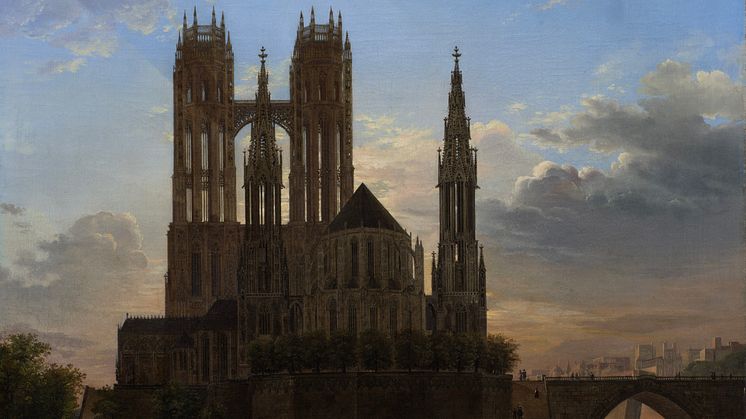
Press release -
Goldstein painting acquired by Nationalmuseum
Nationalmuseum has acquired a painting dated 1822 by Polish-German artist Johann Theodor Goldstein. The imaginary scene depicts a towering cathedral in the early dusk. With its wonderfully visionary qualities, the painting is a novel addition to Nationalmuseum’s German art collection. It will go on show for the first time in autumn 2024 as part of the exhibition entitled The Romantic Eye.
There are few known works by Johann Theodor Goldstein (1798–1871), and the artist is little known today. This is somewhat puzzling, since the recently acquired View of a Gothic Cathedral is a very advanced work that must have required great skill and technical mastery. The cathedral itself is portrayed in wonderful detail, with minute architectural features and ornamentation discernible.
Images of this kind, featuring huge churches, were introduced by the architect and artist Karl Friedrich Schinkel, who produced paintings of elaborate Gothic cathedrals while designing buildings that were strictly classical in style. Schinkel gained a following among certain artists, who either copied his motifs or were freely inspired by them. Goldstein and this painting belong in the latter category. The work was painted during the Romantic era, when the organic nature of Gothic architecture was a source of fascination and the cathedral could be perceived as something that had grown out of the rock of history. As such, it represented the union between man and nature, which the Romantics saw as a symbiosis of human intellect and primeval forces. Moreover, following the French occupation of 1806, Gothic cathedrals came to represent something typically German and, as such, became a central motif in patriotic art.
Carl-Johan Olsson, curator of 19th-century fine art at Nationalmuseum, said:
“This Goldstein painting lets us show Romanticism at its most fantastical and visionary. Nationalmuseum has difficulty purchasing German art, because the trust funds that support our acquisitions are usually restricted to Swedish and French art, so Anne-Marie Lembke’s kind offer to finance this purchase was a godsend.”
Nationalmuseum receives no state funds with which to acquire design, applied art and artwork; instead the collections are enriched through donations and gifts from private foundations and trusts. This acquisition was made possible by generous donations from Anne-Marie Lembke and the Sara and Johan Emil Graumann bequest.
Inventory number
Johann Theodor Goldstein: View of a Gothic Cathedral, 1822. Oil on canvas. NM 7696.
Media contacts
Carl-Johan Olsson, curator, carl-johan.olsson@nationalmuseum.se, +46 8 5195 4324
Hanna Tottmar, head of press, press@nationalmuseum.se, +46 8 5195 4400
Categories
Nationalmuseum is Sweden’s museum of art and design. The collections comprise some 700 000 objects, including paintings, sculpture, drawings and graphic art from the 16th century up to the beginning of the 20th century and the collection of applied art and design up to the present day. Nationalmuseum is a government authority with a mandate to preserve cultural heritage and promote art, interest in art and knowledge of art.

